Abstract
OBJECTIVES--(I) to determine the relative sensitivities of clinical examination, cytology and HPV DNA hybridisation for the detection of anal human papillomavirus infection; and (ii) to examine various factors which may influence presentation of anal human papillomavirus infection in homosexual men. METHODS AND RESULTS--112 unselected homosexual men attending a Sydney STD clinic for routine screening underwent a complete anogenital and physical examination, during which blood samples (for haematological, serological and immunological investigations), rectal swabs (for culture of anal pathogens) and anal scrapes of the dentate line (for cytology and HPV DNA hybridisation) were collected. Papanicolaou-stained anal smears were examined for cytological abnormalities, including those indicative of HPV infection or anal intraepithelial neoplasia (AIN). HPV DNA was detected by high stringency dot hybridisations using radiolabelled HPV 6, 11, 16 and 18 DNA probes. Visible anal condylomata, situated either externally or in the anal canal, were present in 26% of these men; 46% had cytological evidence of HPV infection, and 19% of the smears showed evidence of mild to moderate dysplastic changes (AIN I-II). Detectable HPV DNA was present in 40% of the anal scrapes. By combining these results, a total of 73 men (65%) were found to have at least one of the indicators of HPV infection. These data, together with that relating to HIV antibody, immune status and past or present infection with other STDs, was correlated with information obtained from a questionnaire administered to the patients at the time of their clinical examination. CONCLUSIONS--In this study cytology was found to be slightly more sensitive than HPV DNA dot hybridisation for the detection of HPV infection in the anal canal, providing the full range of HPV-associated cytological changes were accepted as a basis for diagnosis. Clinical anal lesions were more likely to be detected in young men, men who had symptomatic HIV infection and those with a history of past anal wart infection. The latter group also had a higher incidence of cytologically apparent HPV infection in their anal smears. There was a significant association between the detection of HPV 16/18 and the presence of anal dysplasia, but there were no significant correlations between HPV infection or anal dysplasia and HIV antibody, immune function status, sexual practices or history of other STDs.
Full text
PDF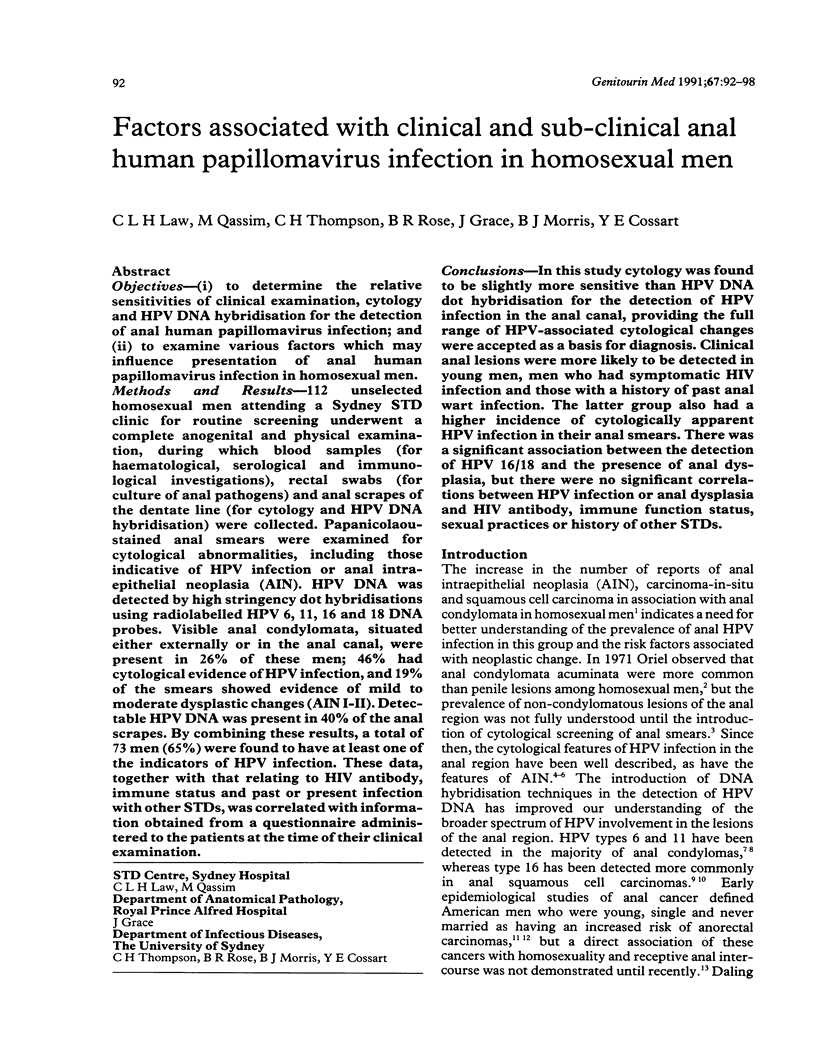

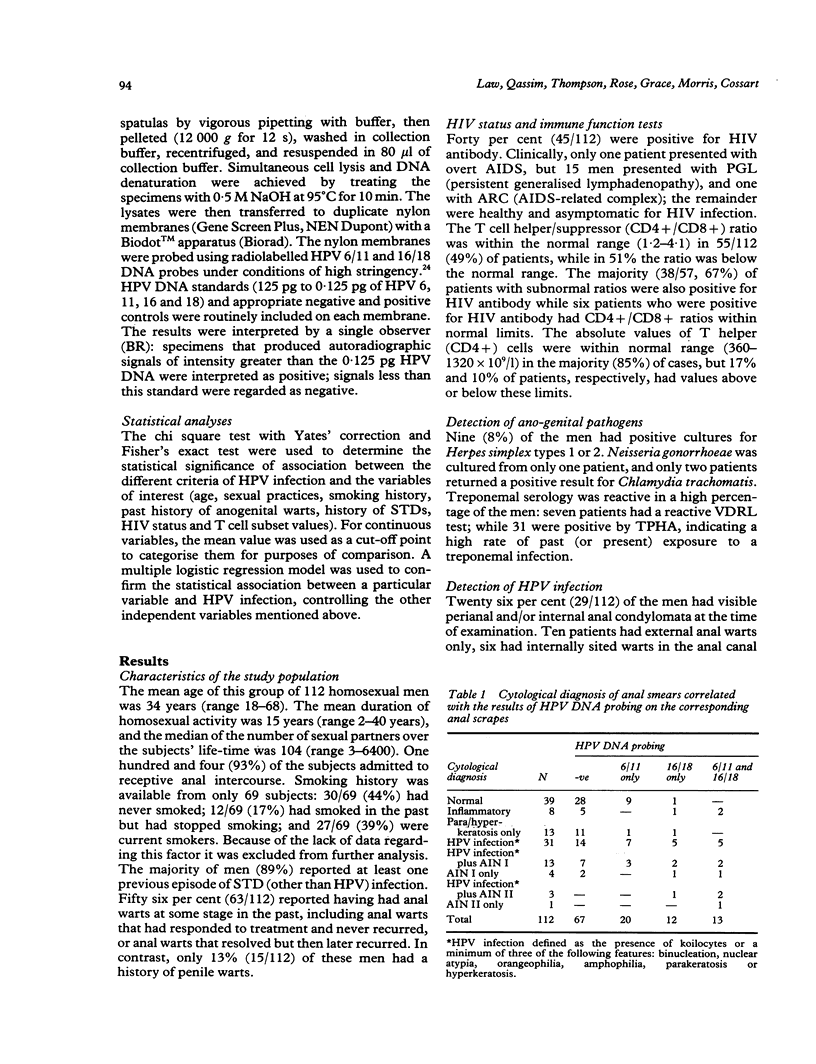
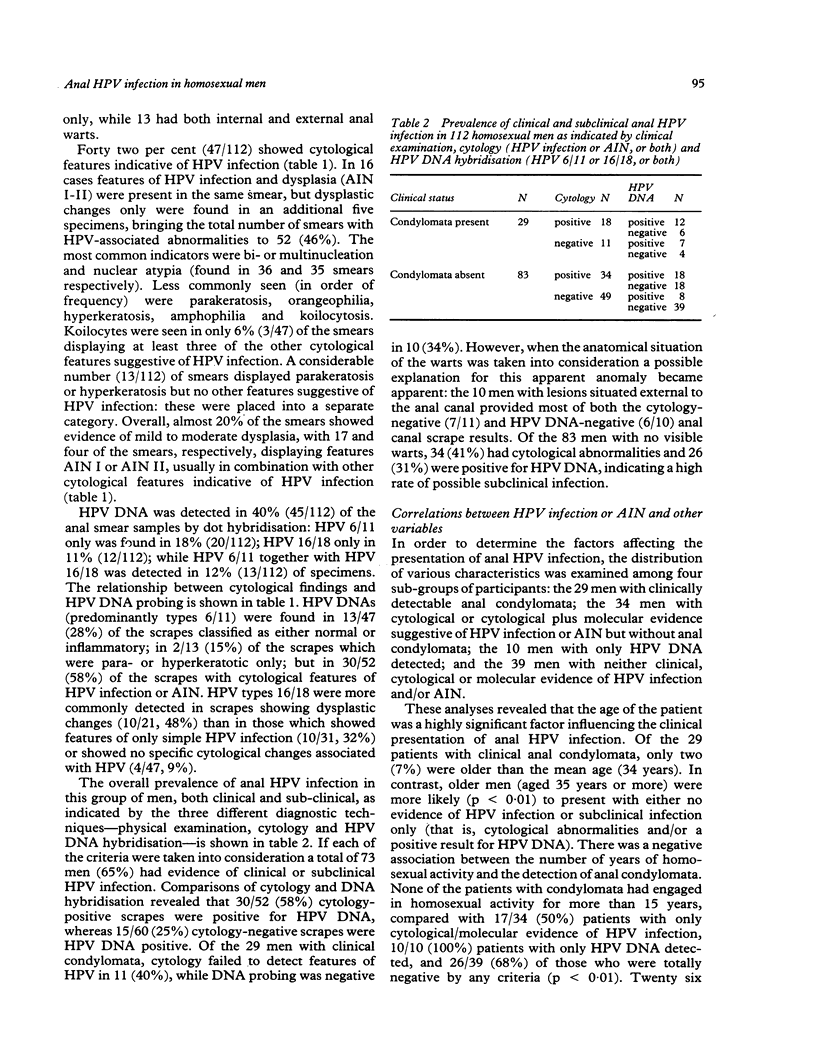
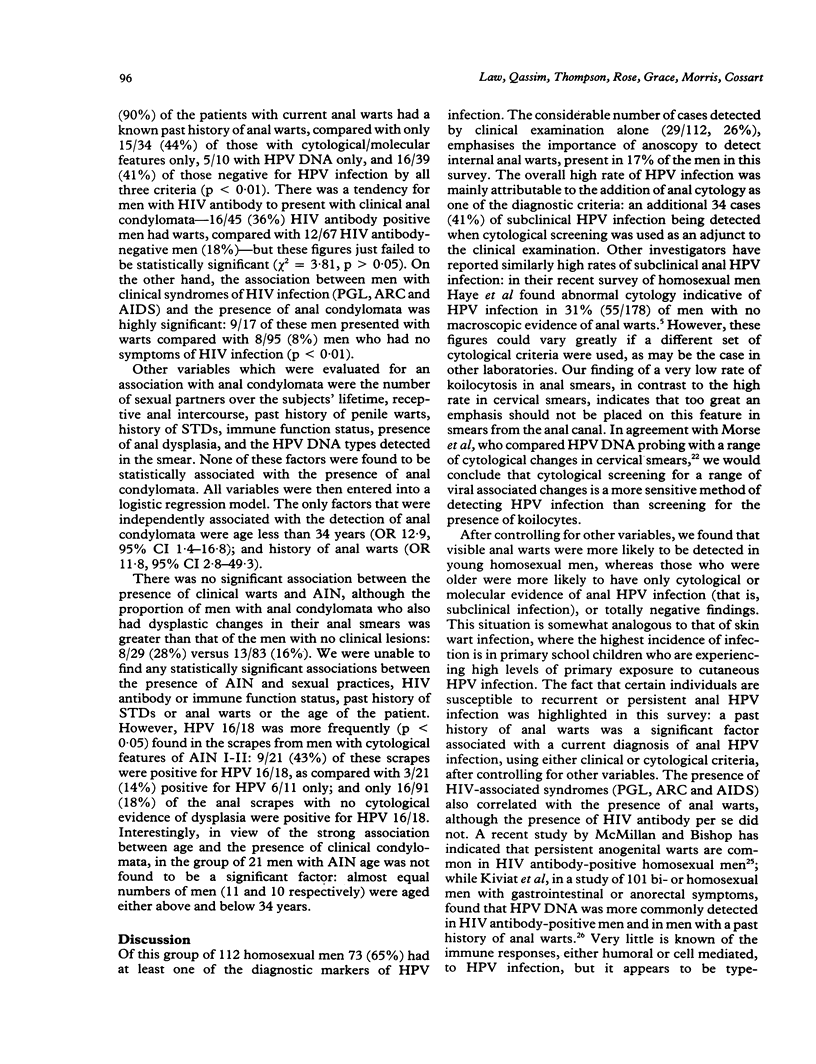
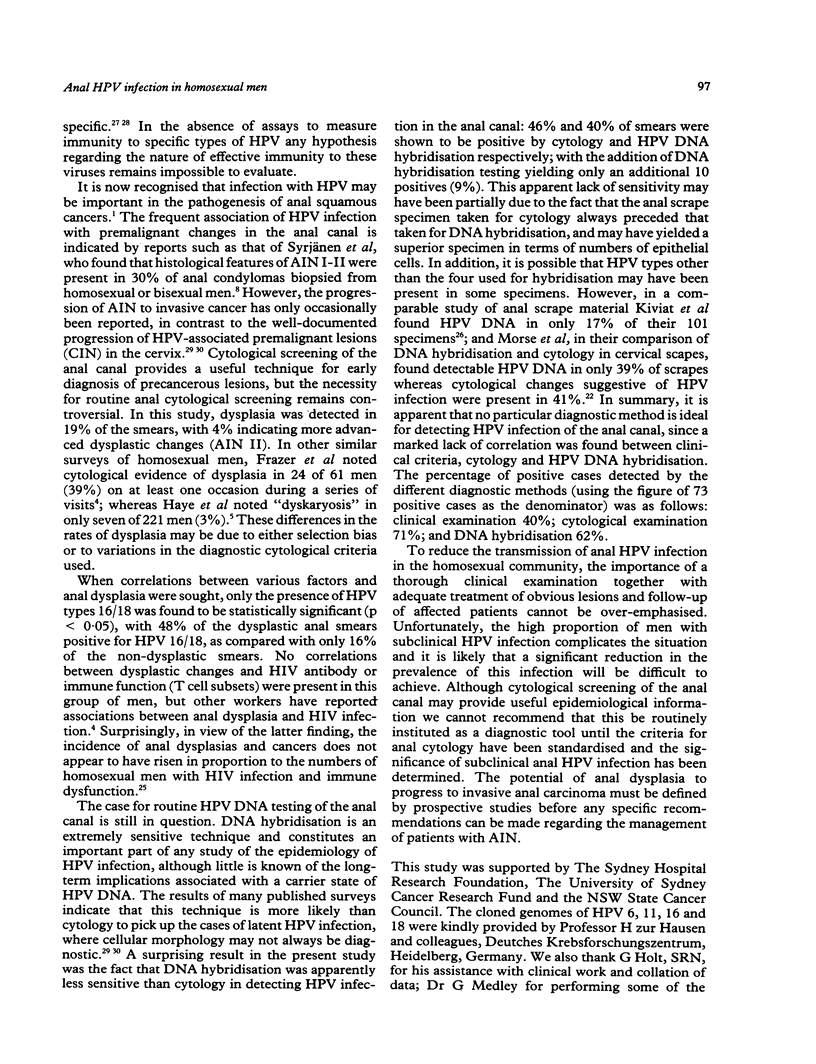
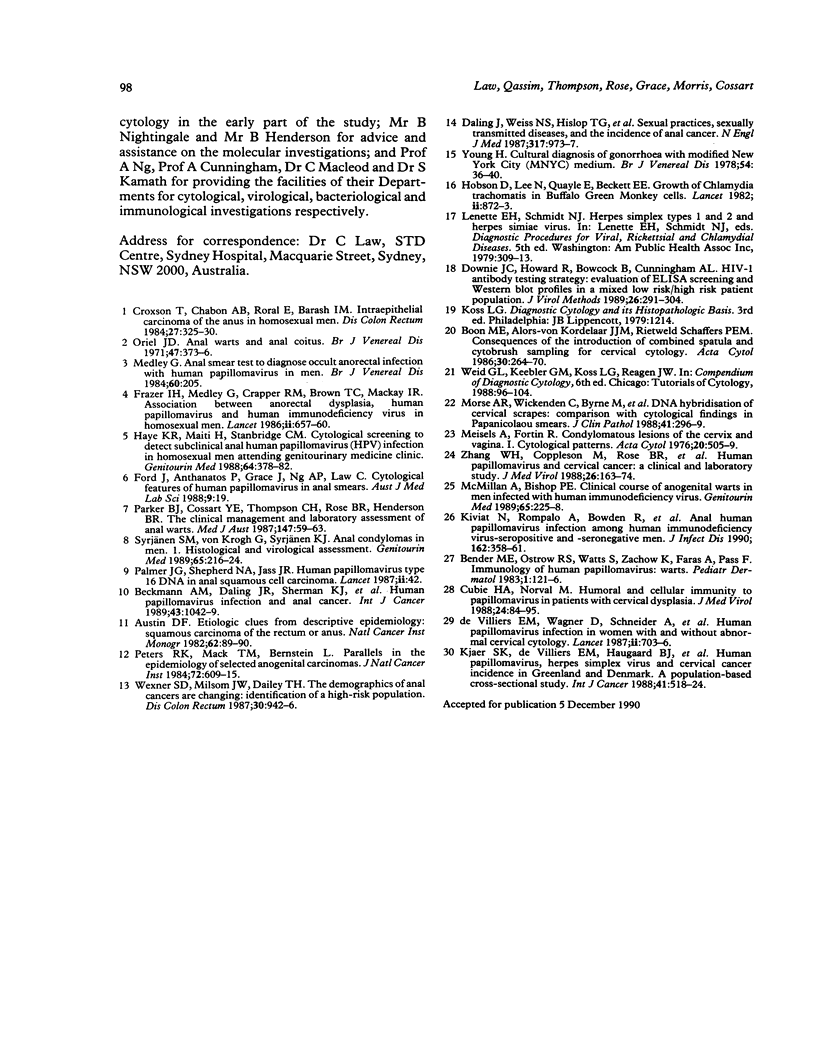
Selected References
These references are in PubMed. This may not be the complete list of references from this article.
- Austin D. F. Etiological clues from descriptive epidemiology: squamous carcinoma of the rectum or anus. Natl Cancer Inst Monogr. 1982;62:89–90. [PubMed] [Google Scholar]
- Beckmann A. M., Daling J. R., Sherman K. J., Maden C., Miller B. A., Coates R. J., Kiviat N. B., Myerson D., Weiss N. S., Hislop T. G. Human papillomavirus infection and anal cancer. Int J Cancer. 1989 Jun 15;43(6):1042–1049. doi: 10.1002/ijc.2910430615. [DOI] [PubMed] [Google Scholar]
- Bender M. E., Ostrow R. S., Watts S., Zachow K., Faras A., Pass F. Immunology of human papillomavirus: warts. Pediatr Dermatol. 1983 Oct;1(2):121–126. doi: 10.1111/j.1525-1470.1983.tb01102.x. [DOI] [PubMed] [Google Scholar]
- Boon M. E., Alons-van Kordelaar J. J., Rietveld-Scheffers P. E. Consequences of the introduction of combined spatula and Cytobrush sampling for cervical cytology. Improvements in smear quality and detection rates. Acta Cytol. 1986 May-Jun;30(3):264–270. [PubMed] [Google Scholar]
- Croxson T., Chabon A. B., Rorat E., Barash I. M. Intraepithelial carcinoma of the anus in homosexual men. Dis Colon Rectum. 1984 May;27(5):325–330. doi: 10.1007/BF02555647. [DOI] [PubMed] [Google Scholar]
- Cubie H. A., Norval M. Humoral and cellular immunity to papillomavirus in patients with cervical dysplasia. J Med Virol. 1988 Jan;24(1):85–95. doi: 10.1002/jmv.1890240111. [DOI] [PubMed] [Google Scholar]
- Daling J. R., Weiss N. S., Hislop T. G., Maden C., Coates R. J., Sherman K. J., Ashley R. L., Beagrie M., Ryan J. A., Corey L. Sexual practices, sexually transmitted diseases, and the incidence of anal cancer. N Engl J Med. 1987 Oct 15;317(16):973–977. doi: 10.1056/NEJM198710153171601. [DOI] [PubMed] [Google Scholar]
- Downie J. C., Howard R., Bowcock B., Cunningham A. L. HIV-1 antibody testing strategy: evaluation of ELISA screening and western blot profiles in a mixed low risk/high risk patient population. J Virol Methods. 1989 Dec;26(3):291–303. doi: 10.1016/0166-0934(89)90111-0. [DOI] [PubMed] [Google Scholar]
- Frazer I. H., Medley G., Crapper R. M., Brown T. C., Mackay I. R. Association between anorectal dysplasia, human papillomavirus, and human immunodeficiency virus infection in homosexual men. Lancet. 1986 Sep 20;2(8508):657–660. doi: 10.1016/s0140-6736(86)90168-6. [DOI] [PubMed] [Google Scholar]
- Haye K. R., Maiti H., Stanbridge C. M. Cytological screening to detect subclinical anal human papillomavirus (HPV) infection in homosexual men attending genitourinary medicine clinic. Genitourin Med. 1988 Dec;64(6):378–382. doi: 10.1136/sti.64.6.378. [DOI] [PMC free article] [PubMed] [Google Scholar]
- Hobson D., Lee N., Quayle E., Beckett E. E. Growth of Chlamydia trachomatis in Buffalo green monkey cells. Lancet. 1982 Oct 16;2(8303):872–873. doi: 10.1016/s0140-6736(82)90831-5. [DOI] [PubMed] [Google Scholar]
- Kiviat N., Rompalo A., Bowden R., Galloway D., Holmes K. K., Corey L., Roberts P. L., Stamm W. E. Anal human papillomavirus infection among human immunodeficiency virus-seropositive and -seronegative men. J Infect Dis. 1990 Aug;162(2):358–361. doi: 10.1093/infdis/162.2.358. [DOI] [PubMed] [Google Scholar]
- Kjaer S. K., de Villiers E. M., Haugaard B. J., Christensen R. B., Teisen C., Møller K. A., Poll P., Jensen H., Vestergaard B. F., Lynge E. Human papillomavirus, herpes simplex virus and cervical cancer incidence in Greenland and Denmark. A population-based cross-sectional study. Int J Cancer. 1988 Apr 15;41(4):518–524. doi: 10.1002/ijc.2910410408. [DOI] [PubMed] [Google Scholar]
- McMillan A., Bishop P. E. Clinical course of anogenital warts in men infected with human immunodeficiency virus. Genitourin Med. 1989 Aug;65(4):225–228. doi: 10.1136/sti.65.4.225. [DOI] [PMC free article] [PubMed] [Google Scholar]
- Meisels A., Fortin R. Condylomatous lesions of the cervix and vagina. I. Cytologic patterns. Acta Cytol. 1976 Nov-Dec;20(6):505–509. [PubMed] [Google Scholar]
- Morse A. R., Wickenden C., Byrne M., Taylor-Robinson D., Smith J., Anderson M. C., Smith C., Malcolm A. D., Coleman D. V. DNA hybridisation of cervical scrapes: comparison with cytological findings in Papanicolaou smears. J Clin Pathol. 1988 Mar;41(3):296–299. doi: 10.1136/jcp.41.3.296. [DOI] [PMC free article] [PubMed] [Google Scholar]
- Oriel J. D. Anal warts and anal coitus. Br J Vener Dis. 1971 Oct;47(5):373–376. doi: 10.1136/sti.47.5.373. [DOI] [PMC free article] [PubMed] [Google Scholar]
- Palmer J. G., Shepherd N. A., Jass J. R., Crawford L. V., Northover J. M. Human papillomavirus type 16 DNA in anal squamous cell carcinoma. Lancet. 1987 Jul 4;2(8549):42–42. doi: 10.1016/s0140-6736(87)93075-3. [DOI] [PubMed] [Google Scholar]
- Parker B. J., Cossart Y. E., Thompson C. H., Rose B. R., Henderson B. R. The clinical management and laboratory assessment of anal warts. Med J Aust. 1987 Jul 20;147(2):59–63. doi: 10.5694/j.1326-5377.1987.tb133259.x. [DOI] [PubMed] [Google Scholar]
- Peters R. K., Mack T. M., Bernstein L. Parallels in the epidemiology of selected anogenital carcinomas. J Natl Cancer Inst. 1984 Mar;72(3):609–615. [PubMed] [Google Scholar]
- Syrjänen S. M., von Krogh G., Syrjänen K. J. Anal condylomas in men. 1. Histopathological and virological assessment. Genitourin Med. 1989 Aug;65(4):216–224. doi: 10.1136/sti.65.4.216. [DOI] [PMC free article] [PubMed] [Google Scholar]
- Wexner S. D., Milsom J. W., Dailey T. H. The demographics of anal cancers are changing. Identification of a high-risk population. Dis Colon Rectum. 1987 Dec;30(12):942–946. doi: 10.1007/BF02554281. [DOI] [PubMed] [Google Scholar]
- Young H. Cultural diagnosis of gonorrhoea with modified New York City (MNYC) medium. Br J Vener Dis. 1978 Feb;54(1):36–40. doi: 10.1136/sti.54.1.36. [DOI] [PMC free article] [PubMed] [Google Scholar]
- Zhang W. H., Coppleson M., Rose B. R., Sorich E. A., Nightingale B. N., Thompson C. H., Cossart Y. E., Bannatyne P. M., Elliott P. M., Atkinson K. H. Papillomavirus and cervical cancer: a clinical and laboratory study. J Med Virol. 1988 Oct;26(2):163–174. doi: 10.1002/jmv.1890260208. [DOI] [PubMed] [Google Scholar]
- de Villiers E. M., Wagner D., Schneider A., Wesch H., Miklaw H., Wahrendorf J., Papendick U., zur Hausen H. Human papillomavirus infections in women with and without abnormal cervical cytology. Lancet. 1987 Sep 26;2(8561):703–706. doi: 10.1016/s0140-6736(87)91072-5. [DOI] [PubMed] [Google Scholar]


